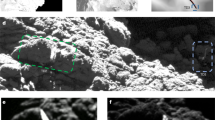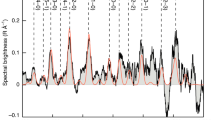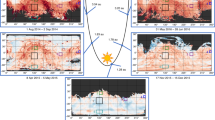Abstract
The remarkable compositional diversity of volatile ices within comets1,2,3 can plausibly be attributed to several factors, including differences in the chemical, thermal and radiation environments in comet-forming regions, chemical evolution during their long storage in reservoirs far from the Sun4, and thermal processing by the Sun after removal from these reservoirs. To determine the relevance of these factors, measurements of the chemistry as a function of depth in cometary nuclei are critical. Fragmenting comets expose formerly buried material, but observational constraints have in the past limited the ability to assess the importance of formative conditions and the effects of evolutionary processes on measured composition5,6,7,8. Here we report the chemical composition of two distinct fragments of 73P/Schwassmann–Wachmann 3. The fragments are remarkably similar in composition, in marked contrast to the chemical diversity within the overall comet population and contrary to the expectation that short-period comets should show strong compositional variation with depth in the nucleus owing to evolutionary processing from numerous close passages to the Sun. Comet 73P/Schwassmann–Wachmann 3 is also depleted in the most volatile ices compared to other comets, suggesting that the depleted carbon-chain chemistry seen in some comets from the Kuiper belt reservoir is primordial and not evolutionary1.
This is a preview of subscription content, access via your institution
Access options
Subscribe to this journal
Receive 51 print issues and online access
$199.00 per year
only $3.90 per issue
Buy this article
- Purchase on Springer Link
- Instant access to full article PDF
Prices may be subject to local taxes which are calculated during checkout


Similar content being viewed by others
References
A’Hearn, M. F., Millis, R. L., Schleicher, D. G., Osip, D. J. & Birch, P. V. The ensemble properties of comets: Results from narrowband photometry of 85 comets, 1976–1992. Icarus 118, 223–270 (1995)
Bockelée-Morvan, D., Crovisier, J., Mumma, M. J. & Weaver, H. A. in Comets II (eds Festou, M. C., Keller, H. U. & Weaver, H. A.) 391–423 (Univ. Arizona Press, Tucson, 2005)
Biver, N. et al. Chemical composition diversity among 24 comets observed at radio wavelengths. Earth Moon Planets 90, 323–333 (2002)
Stern, S. A. The evolution of comets in the Oort cloud and Kuiper belt. Nature 424, 639–642 (2003)
A’Hearn, M. F., Thurber, C. H. & Millis, R. L. Evaporation of ices from Comet West. Astron. J. 82, 518–524 (1977)
Bockelée-Morvan, D. et al. Outgassing behavior and composition of comet C/1999 S4 (LINEAR) during its disruption. Science 292, 1339–1343 (2001)
Gibb, E. L. et al. The organic composition of C/2001 A2 (LINEAR): II. Search for heterogeneity within a comet nucleus. Icarus 188, 224–232 (2007)
Villanueva, G. et al. The volatile composition of the split ecliptic comet 73P/Schwassmann-Wachmann 3: A comparison of fragments C and B. Astrophys. J. 650, L87–L90 (2006)
Fink, U. & Hicks, M. D. A survey of 39 comets using CCD spectroscopy. Astrophys. J. 459, 729–743 (1996)
Schleicher, D., Birch, P. V. & Bair, A. N. The composition of the interior of comet 73P/Schwassmann-Wachmann 3: Results from narrowband photometry of multiple components. Bull. Am. Astron. Soc. 38, 485 (2006)
Boehnhardt, H. et al. 73P/Schwassmann-Wachmann 3 – one orbit after breakup: Search for fragments. Earth Moon Planets 90, 131–139 (2002)
Crovisier, J. et al. What happened to comet 73P/Schwassmann-Wachmann 3? Astron. Astrophys. 310, L17–L20 (1996)
Weaver, H. A. et al. Hubble Space Telescope investigation of the disintegration of 73P/Schwassmann-Wachmann 3. Bull. Am. Astron. Soc. 38, 490 (2006)
Nolan, M. C. et al. Radar observations of comet 73P/Schwassmann-Wachmann 3. Bull. Am. Astron. Soc. 38, 504 (2006)
Greene, T. P., Tokunaga, A. T., Toomey, D. W. & Carr, J. B. CSHELL: A high spectral resolution 1–5 μm cryogenic echelle spectrograph for the IRTF. Proc. SPIE 1946, 313–324 (1993)
McLean, I. S. et al. The design and development of NIRSPEC: A near-infrared echelle spectrograph for the Keck II telescope. Proc. SPIE 3354, 566–578 (1998)
Dello Russo, N., DiSanti, M. A., Mumma, M. J., Magee-Sauer, K. & Rettig, T. W. Carbonyl sulfide in comets C/1996 B2 (Hyakutake) and C/1995 O1 (Hale-Bopp): Evidence for an extended source in Hale-Bopp. Icarus 135, 377–388 (1998)
Mumma, M. J. et al. A survey of organic volatile species in comet C/1999 H1 (Lee) using NIRSPEC at the Keck Observatory. Astrophys. J. 546, 1183–1193 (2001)
Dello Russo, N. et al. Water production and release in comet 153P/Ikeya-Zhang (C/2002 C1): Accurate rotational temperature retrievals from hot-band lines near 2.9-μm. Icarus 168, 186–200 (2004)
Reuter, D. C., Mumma, M. J. & Nadler, S. Infrared fluorescence efficiencies for the ν1 and ν5 bands of formaldehyde in the solar radiation field. Astrophys. J. 341, 1045–1058 (1989)
Dello Russo, N., Mumma, M. J., DiSanti, M. A., Magee-Sauer, K. & Novak, R. Ethane production and release in comet C/1995 O1 Hale-Bopp. Icarus 153, 162–179 (2001)
A’Hearn, M. F. et al. Deep Impact: Excavating comet Tempel 1. Science 310, 258–264 (2005)
Mumma, M. J. et al. Parent volatiles in comet 9P/Tempel 1: Before and after impact. Science 310, 270–274 (2005)
Prialnik, D., Benkhoff, J. & Podolak, M. in Comets II (eds Festou, M. C., Keller, H. U. & Weaver, H. A.) 359–387 (Univ. Arizona Press, Tucson, 2005)
Morfill, G. E. Some cosmochemical consequences of a turbulent protoplanetary cloud. Icarus 53, 41–54 (1983)
Bockelée-Morvan, D., Gautier, D., Hersant, F., Huré, J.-M. & Robert, F. Turbulent radial mixing in the solar nebula as the source of crystalline silicates in comets. Astron. Astrophys. 384, 1107–1118 (2002)
Lisse, C. M. et al. Spitzer spectral observations of the Deep Impact ejecta. Science 313, 635–640 (2006)
Levison, H. F. & Morbidelli, A. The formation of the Kuiper belt by the outward transport of bodies during Neptune’s migration. Nature 426, 419–421 (2003)
Nuth, J. A., Hill, H. G. M. & Kletetschka, G. Determining the ages of comets from the fraction of crystalline dust. Nature 406, 275–276 (2000)
Mumma, M. J. et al. The startling organic composition of C/1999 S4 (LINEAR): A comet formed near Jupiter? Science 292, 1334–1339 (2001)
Acknowledgements
The NASA Planetary Atmospheres and Planetary Astronomy Programs supported this work. Data were obtained at the NASA IRTF operated by the University of Hawaii under cooperative agreement with the NASA Science Mission Directorate, Planetary Astronomy Program. Data were also obtained at the W. M. Keck Observatory, which is operated as a scientific partnership among the California Institute of Technology, the University of California and NASA. The Observatory was made possible by the financial support of the W. M. Keck Foundation. We acknowledge the assistance and expertise of B. Golisch, P. Sears, D. Griep, G. Hill and G. Puniwai, who helped to successfully obtain these data under difficult conditions; and we acknowledge that the summit of Mauna Kea, from which we had the privilege of conducting these observations, is revered within the indigenous Hawaiian community.
Author information
Authors and Affiliations
Corresponding author
Ethics declarations
Competing interests
Reprints and permissions information is available at www.nature.com/reprints. The authors declare no competing financial interests.
Supplementary information
Supplementary Information
This file contains Supplementary Discussion, Supplementary Tables S1 -S2, Supplementary Figures S1-S3 with Legends and additional references. (PDF 1732 kb)
Rights and permissions
About this article
Cite this article
Russo, N., Vervack, R., Weaver, H. et al. Compositional homogeneity in the fragmented comet 73P/Schwassmann–Wachmann 3. Nature 448, 172–175 (2007). https://doi.org/10.1038/nature05908
Received:
Accepted:
Issue Date:
DOI: https://doi.org/10.1038/nature05908
This article is cited by
-
Cometary Nuclei—From Giotto to Rosetta
Space Science Reviews (2020)
-
On the Origin and Evolution of the Material in 67P/Churyumov-Gerasimenko
Space Science Reviews (2020)
-
Comet 67P/CG Nucleus Composition and Comparison to Other Comets
Space Science Reviews (2019)
-
On the Evolution of Comets
Space Science Reviews (2015)
-
The Composition of the Protosolar Disk and the Formation Conditions for Comets
Space Science Reviews (2015)
Comments
By submitting a comment you agree to abide by our Terms and Community Guidelines. If you find something abusive or that does not comply with our terms or guidelines please flag it as inappropriate.



